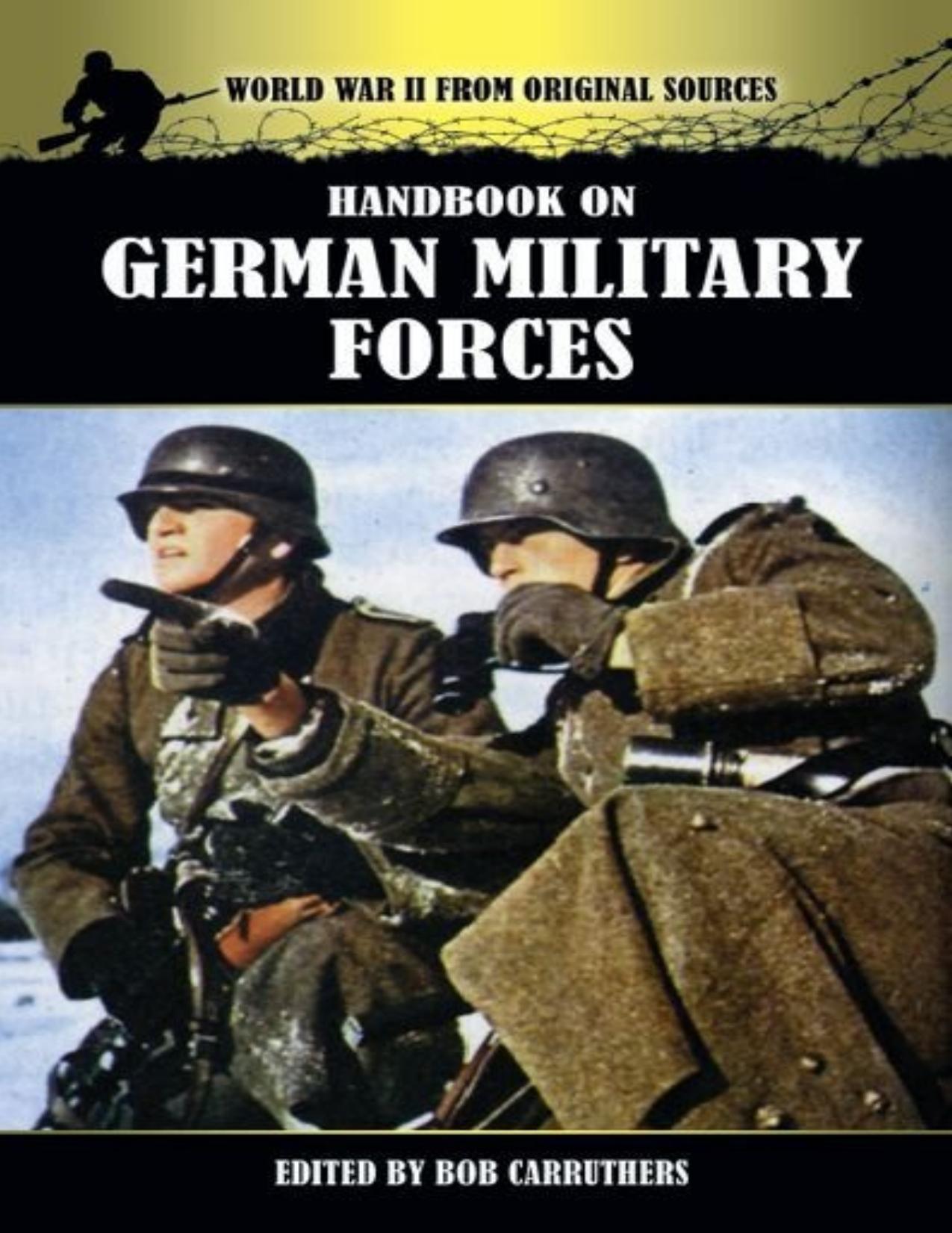Handbook on German Military Forces (World War II from Original Sources) by Bob Carruthers

Author:Bob Carruthers [Carruthers, Bob]
Language: eng
Format: epub, pdf
Tags: HISTORY / Reference
ISBN: 9781473846494
Publisher: Pen and Sword
Published: 2013-05-15T07:00:00+00:00
CHAPTER V
FORTIFICATIONS AND DEFENSES
SECTION I: DOCTRINE OF FORTIFICATIONS
1. Economy of Force
The Germans regard economy of force as a fundamental principle in designing fortifications. In conformity with this view, they employ defense works to permit a relatively smaller force to defend a line than otherwise would be required. German troops are taught that fortifications exist not for their personal safety but to enable them to fight more effectively, although fortified works, especially those of reinforced concrete, naturally make for a lower casualty rate. The German doctrine of offensive warfare therefore is not affected by the construction of strong systems of defense. Such systems in fact may be considered to be offensive rather than defensive in purpose, since they make it possible to concentrate a relatively large proportion of the field forces for action at any given point. In September 1939, the Westwall (Siegfried Line) [The Germans do not employ the term “Siegfried Line”.] enabled the Germans to hold their Western Front with Approximately 20 divisions, while employing 40 to 50 divisions against Poland. These latter troops, in turn, could be concentrated on the northern and southern parts of the Polish border for a double envelopment of the Polish forces, since the vulnerable central sector due east of Berlin was protected by the so-called Oder Quadrilateral, a zone of permanent defense works constructed between 1935 and 1939. Again, in May 1940, the Westwall played an important role—this time in the envelopment of the Maginot Line—for, while the French border was held with relatively weak forces, the bulk of the Wehrmacht wheeled through Belgium and Luxembourg.
2. Organization of Defenses
a. PRINCIPLE OF DEPTH.
The Germans believe that a fortified line should consist of small works organized in great depth. This principle, embodied in the Westwall, is directly opposed to that of the French Maginot Line, which was a continuous wall of mammoth forts with little, if any, depth. The German idea is that a fortified line should not be employed to present an unyielding front to an attacker, but rather to act as a shock absorber and gradually slow down the advance. Then, when the attack has lost its momentum, counterattacks can be launched to destroy the penetration before the attacker has reorganized and consolidated his gains. The importance the Germans attach to counterattack is shown by the fact that they keep their best assault troops for this purpose and man the concrete positions with inferior soldiers. In order to impede the enemy’s advance as much as possible and to facilitate the counterattack, troops manning the fortifications are taught to continue fighting even though their positions are overrun.
b. ZONES OF DEFENSE.
The Germans achieve depth in a fortified line by constructing successive zones of defense. In a typical segment of the Westwall, there are three independent zones from front to rear.
(1) The Forward Zone (Vorfeldzone) contains field fortifications including trenches, barbed-wire entanglements, machine-gun emplacements, and observation posts.
(2) The Main Defense Zone (Grosskampfzone) comprises fortified structures such as pillboxes, casemates and shelters, and antitank obstacles covered by antitank guns.
Download
Handbook on German Military Forces (World War II from Original Sources) by Bob Carruthers.pdf
This site does not store any files on its server. We only index and link to content provided by other sites. Please contact the content providers to delete copyright contents if any and email us, we'll remove relevant links or contents immediately.
| Africa | Americas |
| Arctic & Antarctica | Asia |
| Australia & Oceania | Europe |
| Middle East | Russia |
| United States | World |
| Ancient Civilizations | Military |
| Historical Study & Educational Resources |
Flight by Elephant(1481)
The Rise and Fall of the Third Reich: A History of Nazi Germany by William L. Shirer(1384)
Unbroken: A World War II Story of Survival, Resilience, and Redemption by Hillenbrand Laura(1100)
German submarine U-1105 'Black Panther' by Aaron Stephan Hamilton(1018)
Last Hope Island by Lynne Olson(934)
A Bridge Too Far by Cornelius Ryan(928)
The Victors - Eisenhower and His Boys The Men of World War II by Stephen E. Ambrose(904)
War by Unknown(904)
The Guns at Last Light: The War in Western Europe, 1944-1945 by Rick Atkinson(888)
Rogue Heroes: The History of the SAS, Britain's Secret Special Forces Unit That Sabotaged the Nazis and Changed the Nature of War by Ben Macintyre(884)
0060740124.(F4) by Robert W. Walker(872)
The Hitler Options: Alternate Decisions of World War II by Kenneth Macksey(865)
The Railway Man by Eric Lomax(847)
All the Gallant Men by Donald Stratton(815)
Hitler's Vikings by Jonathan Trigg(809)
A Tragedy of Democracy by Greg Robinson(800)
Churchill's Secret War by Madhusree Mukerjee(798)
Hitler's Armies by Chris McNab(781)
We Die Alone: A WWII Epic of Escape and Endurance by David Howarth & Stephen E. Ambrose(746)
